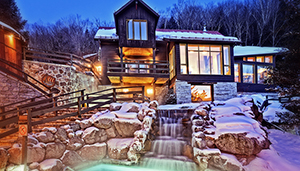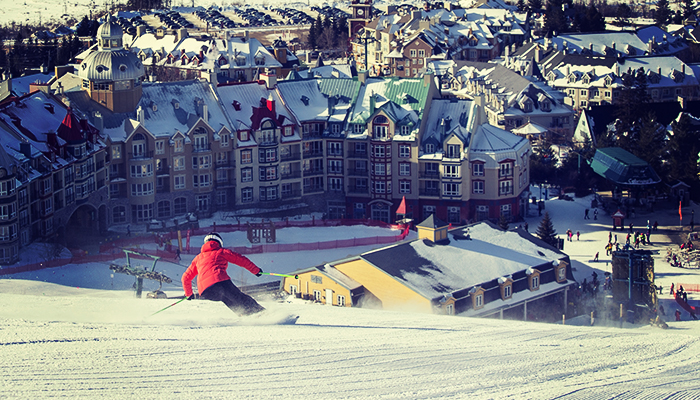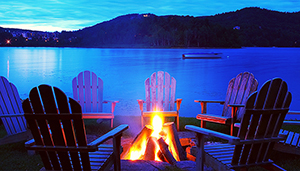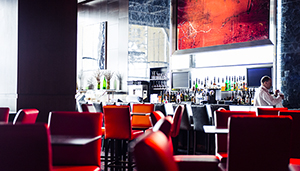
Only 80 miles north of Montreal, Mont-Tremblant is a beckoning oasis carved out of the Laurentian mountain range. Mont-Tremblant has cobblestone streets lined with buildings that mimic Montreal’s Old City but with vibrant red, teal and marigold facades and roofs. The pedestrian village lies at the foot of the highest mountain of the Laurentians and offers some of the best slopes in eastern North America. But even if you don’t ski, the charming little resort town teems with activities, from dogsledding to fine dining.
Opened in 1939 by American Joe Ryan, Mont-Tremblant is the second-oldest ski resort in North America (Idaho’s Sun Valley nabs the No. 1 title). But the Mont-Tremblant you see today is relatively new—Canadian company Intrawest acquired the almost-bankrupt ski resort in 1991 and developed it into what Ryan thought it could be—a world-class destination. Here’s what you should do during your visit to Mont-Tremblant.
Where to Stay
The best place to stay in Mont-Tremblant is Forbes Travel Guide Four-Star Hôtel Quintessence. The cozy Old World-inspired boutique hotel puts you in a prime location—you’re only a two-minute walk from the pedestrian village and the property sits along peaceful Lake Tremblant just outside the throngs of skiers and tourists. All 30 of the spacious, warm suites come with lake views, a balcony or terrace and a wood-burning fireplace. Be sure to relish the deep-soaking tub (it’s so deep, a step stool is provided), which comes with massaging jets and chromotherapy lights that you can set via remote control.
What to Do Outdoors
Of course, skiing and snowboarding are the big draws. With 662 acres of diverse skiable terrain, Mont-Tremblant offers 96 ski trails on four slopes. It’s a great place for beginners, with the south side’s 3.7-mile Nansen run—the mountain’s longest and a rare feature—providing a good introduction to the sport, and the local ski school is considered one of the best in North America. Veterans will be challenged with glades on the north side’s The Edge. Ski season lasts from November through April.
Even if you don’t ski, it’s worth a visit to the top of the 2,871-foot summit for an amazing vista of the Laurentians (go right when the lift opens at 7:45 a.m. to see the sunrise illuminating the surrounding snow-covered mountains with fewer skiers in the way).
Tremblant is the place for outdoor activities—and they go beyond skiing. Take a snowshoe and fondue tour for a two- or three-mile guided nighttime trek through the snowy mountain terrain with only your headlamp and moon lighting the way. Snowshoeing is a workout, but you’ll be rewarded with a stop in a rustic cabin for hot fondue spiked with Sortilège, a whiskey with maple syrup that adds a subtle sweetness. It’s so addictive, you won’t be able to resist dunking cauliflower, bread, sausage, broccoli and other food in the cheese (for dessert, you’ll have chocolate fondue and fruit) as a singer/acoustic guitarist tries to get you to sing along to traditional Québécois songs and English-language favorites (“Brown-Eyed Girl,” “Billie Jean”).
When you need a break from the slopes, book a dogsledding adventure with Expedition Wolf. You’ll help gather and harness your own pack of gorgeous huskies (the company keeps 250 of the friendly, thick-coated beauties, about 120 of whom are rescues). The guides give some basic driving instructions and then leave you to the dogs, who are eager to run (so be sure to hold on before they run off). There’s a pit stop at a log cabin for hot chocolate and maple cookies, but for the most part, you’re mushing. Leading your own team of huskies through six miles of forest in the Laurentians as snow softly falls is exhilarating. After the dogsledding, the guides will let you meet and pet the rest of the huskies and then you’ll warm up with some soup or tea in the main house. Another option: Lace up to ice skate at the rink around Chapelle St-Bernard (skating is free for guests staying in Mont-Tremblant hotels)—the scene looks ready made for a snowglobe; lights and music liven it up at night. Or visit the Tremblant Activity Centre to sign up for snowmobiling, tubing, sleigh rides or ice fishing.
Our favorite way to unwind after a day of skiing is in the picturesque outdoor Scandinavian baths at the Scandinave Spa, set high in a quiet mountainside spot along the Diable River that’s a five-minute drive from Tremblant Resort. Rest your weary muscles in a hot tub among snow-dusted firs and deer in utter silence (there’s a no-talking-allowed policy).
To maximize the visit, do three to four hydrotherapy circuits of hot (hot tub, eucalyptus steam room or Finnish sauna), cold (Nordic waterfalls, cold showers or the river) and relaxation (solariums or outdoor fireplace). Many locals wouldn’t dare plunge into the iced-over river in the winter, but we decided to be adventurous. We dipped our bodies in up to our chins in the carved-out river. The piercing cold water shocked our senses, but afterward, relaxation seeped into every part of our body as we leaned back on a zero-gravity chair in the serene solarium overlooking the snowy environs through big-picture windows.
What to Do Indoors
One of the features that makes Mont-Tremblant stand out is its quaint cobblestone pedestrian village sprinkled with standalone huts. Peruse the European-inspired village’s more than 35 shops, like Joaillerie St-Onge, which showcases a Montreal designer’s vintage-inspired fine jewelry, and Bagnoles et Bobinette, an old-fashioned toy shop. Be sure to stop into Cabane à Sucre de la Montagne near the cabriolet (an open-air gondola that gives you nice views of the village), where you’ll see crowds in front pulling maple taffy from the snow. Duck inside the family-owned maple shop to pick up Manon Henri’s mouthwatering maple butter and maple caramel to bring home.
Around 11 a.m. daily, an enticing chocolate aroma wafts throughout Place St-Bernard at the base of the mountain. Resist the temptation to fill up on fudge because the small area has a surprising number of good dining spots, from authentic Italian (Coco Pazzo) to a fine-dining grill (La Forge Grill). Even if you aren’t much of a gambler, visit the casino’s top-floor Altitude. It serves typical grill fare, everything from lobster tails to prime rib. But South of France native Éric Gonzalez, who took the helm of the kitchen in December 2014, adds unexpected touches, like the popcorn amuse-bouche with soft polenta, a drizzle of truffle oil and Parmesan. The modern space gives you a look at the mountains, but your eyes will fall on the elegant, almost seven-foot-long chandelier with fluttering glass leaves.
For a local institution, head to La Savoie. Taking up residence in one of the huts in the pedestrian village, the traditional wood-filled restaurant looks straight out of the French Alps. Diners come for the fondue, but stay for the raclette, a unique offering. A metal contraption holds a half a wheel of raclette cheese right next to a heater. Gooey, delicious gobs of cheese slide off the edge of the cut wheel, which you scrape off to put on top of prosciutto, boiled potatoes, salami and bread.
One of the newest spots to open is Gypsy, set inside the recently revamped Le Westin Resort & Spa. It’s easy to mistake the Mediterranean tapas restaurant as a grab-and-go place, but small plates like the warm goat cheese with sautéed spinach, olive oil and garlic confit, and Serrano-ham-wrapped scallops with wasabi cream and sesame seeds make it worth sitting down for a full meal.
Craft beer fans won’t want to miss Microbrasserie La Diable—the popular restaurant is the only place in the world you can taste the Quebec microbrewery’s brews. Order the Extrême-Onction, a full-bodied, Belgian-style trappist ale with a relatively high alcohol kick, and the Swiss-cheese-filled sausage with a side of poutine (this is Canada, after all). Wine aficionados should hit Hôtel Quintessence’s intimate, romantic Winebar (also a chic après-ski spot), to choose from 5,000 bottles to pair with chef Georges Laurier’s French dishes, like Nordic venison medallions with Labrador tea, spinach puree and pepper sauce.




